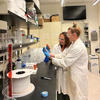Project 4: Designing selective sorbents for water remediation
Project 4 Cross-Country Collaborative Externship
. 3/30/2023. “Understanding the Effect of Single Atom Cationic Defect Sites in an Al2O3 (012) Surface on Altering Selenate and Sulfate Adsorption: An Ab Initio Study.” J. Phys. Chem. C, 127, 14, Pp. 6925-6937. Publisher's VersionAbstract
Novel water filter device deployed in Florence, AZ
Emily Briese to present work on selective adsorption
Paul Westerhoff elected to National Academy of Engineering
. 2021. “Unified Metallic Catalyst Aging Strategy and Implications for Water Treatment.” Environ Sci Technol.Abstract
. 2022. “Lithium occurrence in drinking water sources of the United States.” Chemosphere, 305, Pp. 135458.Abstract
Srishti Gupta receives Outstanding Mentor Award
Muhich gives invited seminars on adsorption research
2022
Oct
17








